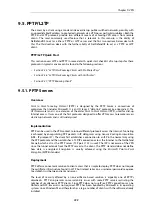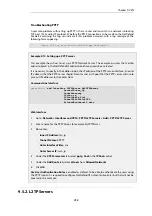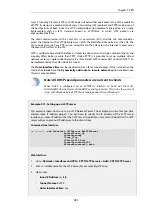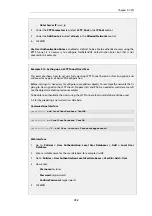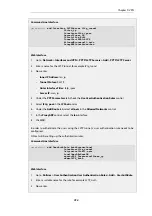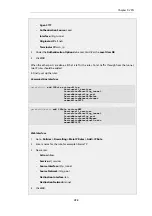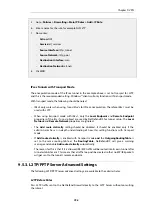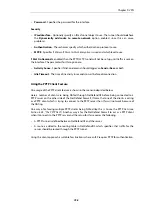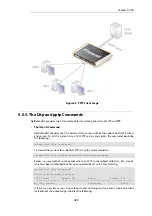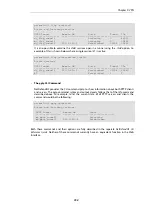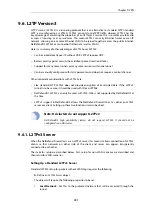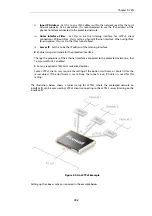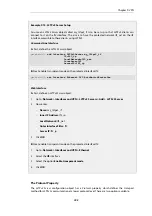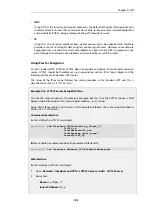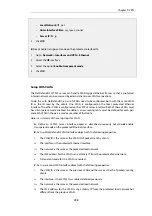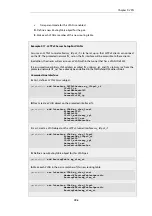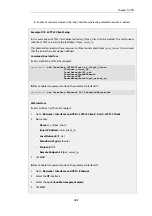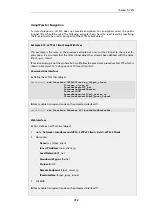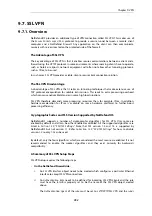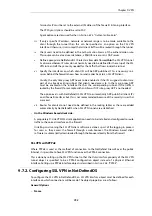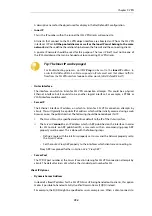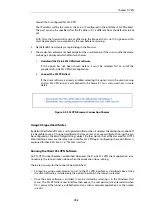
9.6. L2TP Version 3
L2TP Version 3
(L2TPv3) is a tunneling protocol that is an alternative to standard L2TP (standard
L2TP is also referred to as L2TPv2). L2TPv2 can only tunnel PPP traffic, whereas L2TPv3 has the
key advantage of emulating the properties of an OSI layer 2 service. This is sometimes referred to
as
Layer 2 Tunneling
or as a
pseudowire
. This means L2TPv3 can carry Ethernet frames over an IP
network, allowing one or more Ethernet LANs to be joined together across the public internet.
NetDefendOS L2TPv3 can tunnel both Ethernet as well as VLANs.
Here is a summary of other advantages of L2TPv3 over L2TPv2:
•
Can be carried directly over IP without UDP. L2TPv2 requires UDP.
•
Better security against man-in-the-middle or packet-insertion attacks.
•
Support for many more tunnels or many more sessions within one tunnel.
•
Can be manually configured with static parameters and does not require a control channel.
Other important considerations with L2TPv3 are:
•
Like standard L2TP, L2TPv3 does not provide encryption of transmitted data. If the L2TPv3
tunnel is to be secure, it should be used with IPsec or PPPoE.
•
NetDefendOS L2TPv3 can only be used with IPv4. IPv6 is not supported by NetDefendOS at
this time.
•
L2TPv3 support in NetDefendOS allows the NetDefend Firewall to act as either an
L2TPv3
server or a client. Setting up these two functions is described next.
Note: HA clusters do not support L2TPv3
NetDefendOS high availability clusters do not support L2TPv3. It should not be
configured in an HA cluster.
9.6.1. L2TPv3 Server
When the NetDefend Firewall acts as an L2TPv3 server this means it allows connection of L2TPv3
clients so that networks on either side of the client and server can appear transparently
connected to each other.
The steps for setup are described below. First, setup for non-VLAN scenarios are described and
then setup for VLAN scenarios.
Setting Up a Standard L2TPv3 Server
Standard L2TPv3 setup for packets without VLAN tags requires the following:
A. Define an
L2TPv3 Server
object.
The object will require the following properties to be set:
i.
Local Network - Set this to the protected network that will be accessed through the
tunnel.
Chapter 9: VPN
741
Summary of Contents for NetDefendOS
Page 30: ...Figure 1 3 Packet Flow Schematic Part III Chapter 1 NetDefendOS Overview 30 ...
Page 32: ...Chapter 1 NetDefendOS Overview 32 ...
Page 144: ...Chapter 2 Management and Maintenance 144 ...
Page 284: ...Chapter 3 Fundamentals 284 ...
Page 392: ...Chapter 4 Routing 392 ...
Page 419: ... Host 2001 DB8 1 MAC 00 90 12 13 14 15 5 Click OK Chapter 5 DHCP Services 419 ...
Page 420: ...Chapter 5 DHCP Services 420 ...
Page 573: ...Chapter 6 Security Mechanisms 573 ...
Page 607: ...Chapter 7 Address Translation 607 ...
Page 666: ...Chapter 8 User Authentication 666 ...
Page 775: ...Chapter 9 VPN 775 ...
Page 819: ...Chapter 10 Traffic Management 819 ...
Page 842: ...Chapter 11 High Availability 842 ...
Page 866: ...Default Enabled Chapter 13 Advanced Settings 866 ...
Page 879: ...Chapter 13 Advanced Settings 879 ...



